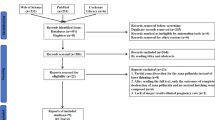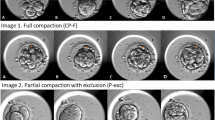Abstract
Purpose
The aim of this study was to determine if zona pellucida thickness variation (ZPTV) is associated with implantation and if this relationship changes with use of assisted hatching (AH).
Methods
Day 3 embryos from single or double embryo transfers (DETs) performed between 2014 and 2016 were included. ZPTV was assessed by examining photographs taken before transfer using an automated image processing platform to segment the zona pellucida (ZP) with an active contour technique. One hundred points were obtained of ZP thickness (ZPT) of each embryo to calculate ZPTV ([maximum ZPT–mean ZPT]/mean ZPT). Logistic regression was used to calculate the odds ratio (OR) and 95% confidence intervals (CI) of implantation by tertile of ZPTV. Maternal age and AH were adjusted for a priori. Other cycle and embryo characteristics were adjusted for if they altered the continuous effect estimate by >10%.
Results
There was no statistically significant association between ZPTV and implantation across tertiles although embryos with greater ZPTV showed a trend of decreased implantation (Tertile 2 (T2) versus Tertile 1 (T1), OR = 0.80, CI = 0.50–1.28; Tertile 3 (T3) versus Tertile 1 (T3), OR = 0.75, CI = 0.47–1.20). While similar nonsignificant trends for the association between ZPTV and implantation were observed across tertiles after stratification of embryos hatched or not, embryos with the greatest ZPTV had slightly higher odds for implantation when AH was utilized (T3 vs. T1: with AH, OR = 0.89, CI = 0.49–1.62; without AH, OR = 0.61, 0.29–1.27).
Conclusion
ZPTV was not associated with implantation after day 3 transfer. This finding did not vary by use of AH.




Similar content being viewed by others
References
Cohen J. Assisted hatching of embryos. J In Vitro Fert Embryo Trans. 1991;8:179–90.
Balakier H, Sojecki A, Motamedi G, et al. Is the zona pellucida thickness of human embryos influenced by women’s age and hormonal levels? Fertil Steril. 2012;98:77–83.
Sinowatz F, Topfer-Peterson E, Kolle S, et al. Functional morphology of the zona pellucida. Anat Histol Embryol. 2001;30:257–63.
Lefievre L, Conner SJ, Salpekar A, Olufowobi O, Ashton P, Pavlovic B, et al. Four zona pellucida glycoproteins are expressed in the human. Hum Reprod. 2004;19:1580–6.
Pelletier C, Keefe DL, Trimarchi JR. Noninvasive polarized light microscopy quantitatively distinguishes the multilaminar structure of the zona pellucida of living human eggs and embryos. Fertil Steril. 2004;81(Suppl 1):850–6.
Cohen J, Inge KL, Suzman M, Wiker SR, Wright G. Videocinematography of fresh and cryopreserved embryos: a retrospective analysis of embryonic morphology and implantation. Fertil Steril. 1989;51:820–7.
De Vos A, Van Steirteghem A. Zona hardening, zona drilling and assisted hatching: new achievements in assisted reproduction. Cells Tissues Organs. 2000;166:220–7.
Palmstierna M, Murkes D, Csemiczky G, Andersson O. Zona pellucida thickness variation and occurrence of visible mononucleated blastomeres in pre-embryos are associated with a high pregnancy rate in IVF treatment. J Assist Reprod Genet. 1998;15:70–5.
Sun YP, Xu Y, Cao T, Su YC, Guo YH. Zona pellucida thickness and clinical pregnancy outcome following in vitro fertilization. Int J Gynecol Obstet. 2005;89:258–62.
Gabrielsen A, Lindenberg S, Petersen K. The impact of zona pellucida thickness variation of human embryos on pregnancy outcome in relation to suboptimal embryo development. A prospective randomized controlled study. Hum Reprod. 2001;16:2166–70.
Cohen J, Alikani M, Trowbridge J, Rosenwaks Z. Implantation enhancement by selective assisted hatching using zona drilling of human embryos with poor prognosis. Hum Reprod. 1992;7:685–91.
Loret De Mola JR, Garside WT, Bucci J, Tureck RW, Heyner S. Analysis of the human zona pellucida during culture: correlation with diagnosis and the preovulatory hormonal environment. J Assist Reprod Genet. 1997;14:322–6.
Garside WT, Loret De Mola JR, Bucci JA, Tureck RW, Heyner S. Sequential analysis of zona thickness during in vitro culture of human zygotes: correlation with embryo quality, age, and implantation. Mol Reprod Dev. 1997;47:99–104.
Marco-Jimenez F, Naturil-Alfonso C, Jimenez-Trigos E, Lavara R, Vicente JS. Influence of zona pellucida thickness on fertilization, embryo implantation and birth. Anim Reprod Sci. 2012;132:96–100.
Hagemann AR, Lazendorf SE, Jungheim ES, et al. A prospective, randomized, double-blinded study of assisted hatching in women younger than 38 years undergoing in vitro fertilization. Fertil Steril. 2010;93:586–91.
Kissin DM, Kawwass JF, Monsour M, Boulet SL, Session DR, Jamieson DJ, et al. Surveillance System (NASS) group. Assisted hatching: trends and pregnancy outcomes, United States, 2000-2010. Fertil Steril. 2014;102:795–801.
Kanter JR, Boulet SL, Kawwass JF, Jamieson DJ, Kissin DM. Trends and correlates of monozygotic twinning after single embryo transfer. Obstet Gynecol. 2015;125:111–7.
Hershlag A, Paine T, Cooper GW, et al. Monozygotic twinning associated with mechanical assisted hatching. Fertil Steril. 1999;71:144–6.
Luke B, Brown MB, Wantman E, et al. Factors associated with monozygosity in assisted reproductive technology pregnancies and the risk of recurrence linked cycles. Fertil Steril. 2014;101:683–9.
Schiewe MC, Whitney JB, Anderson RE. Potential risk of monochorionic dizygotic twin blastocyst formation associated with early laser dissection of group culture embryos. Fertil Steril. 2015;103:417–21.
Skiadas CC, Missmer SA, Benson CB, Gee RE, Racowsky C. Risk factors associated with pregnancies containing a monochorionic pair following assisted reproductive technologies. Hum Reprod. 2008;23:1366–71.
Carney SK, Das S, Blake D, Farquhar C, Seif MM, Nelson L. Assisted hatching on assisted conception in vitro fertilization (IVF) and intracytoplasmic sperm injection (ICSI). Cochrane Database Syst Rev. 2012;12:CD001894.
Martins WP, Rocha IA, Ferriani RA, Nastri CO. Assisted hatching human embryos: a systematic review and meta-analysis of randomized controlled trials. Hum Reprod Update. 2011;17:438–53.
Shi W, Hongwei T, Zhang W, Li N, Li M, Li W, et al. A prospective randomized controlled study of laser-assisted hatching on the outcome of first fresh IVF-ET cycle in advanced age women. Reprod Sci. 2016;23:1397–401.
Butts SF, Owen C, Mainiqi M, Senapati S, Seifer DB, Dokras A. Assisted hatching and intracytoplasmic sperm injection are not associated with improved outcomes in assisted reproduction cycles for diminished ovarian reserve: an analysis of cycles in the United States from 2004 to 2011. Fertil Steril. 2013;102:1041–7.
Machtinger R, Bormann CL, Ginsburg ES, Racowsky C. Is the presence of a non-cleaved embryo on day 3 associated with poorer quality of the remaining embryos in the cohort? J Assist Reprod Genet. 2015;32:677–83.
Racowsky C, Combelles CMH, Nureddin A, Pan Y, Finn A, Miles L, et al. Day 3 and day 5 morphological predictors of embryo viability. Reprod BioMed Online. 2003;6:323–31.
Farhadifar R, Needleman D. Automated segmentation of the first mitotic spindle in differential interference contrast microscopy images of C. elegans embryos. Methods Mol Biol. 2014;1136:41–5.
Kass M, Witkin A, Terzopoulos D. Snakes: active contour models. Int J Comput Vis. 1988;1:321.
Greenland S. Modeling and variable selection in epidemiologic analysis. Am J Public Health. 1989;79:340–9.
Goldman RH, Kaser DJ, Missmer SA, Srouji SS, Farland LV, Racowsky C. Building a model to increase live birth rate through patient-specific optimization of embryo transfer day. J Assist Reprod Genet. 2016;33:1525–32.
Author information
Authors and Affiliations
Corresponding author
Ethics declarations
Conflict of interest
The authors declare they have no conflict of interest.
Funding
This study was partially funded by the New England Fertility Society REI Fellow Research grant supported by Ferring Pharmaceuticals, Inc.
Rights and permissions
About this article
Cite this article
Lewis, E.I., Farhadifar, R., Farland, L.V. et al. Use of imaging software for assessment of the associations among zona pellucida thickness variation, assisted hatching, and implantation of day 3 embryos. J Assist Reprod Genet 34, 1261–1269 (2017). https://doi.org/10.1007/s10815-017-0978-3
Received:
Accepted:
Published:
Issue Date:
DOI: https://doi.org/10.1007/s10815-017-0978-3




